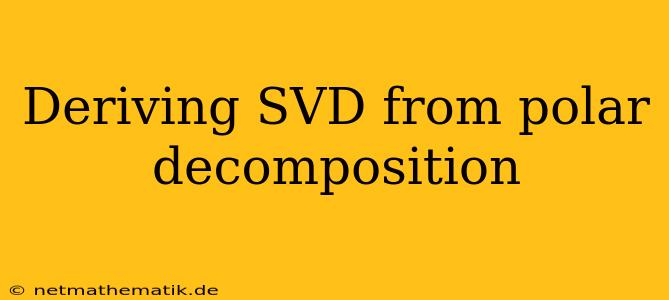The singular value decomposition (SVD) is a fundamental tool in linear algebra and data analysis, providing a powerful way to decompose matrices into meaningful components. One way to understand the SVD is through its connection to the polar decomposition, a closely related concept that sheds light on the geometric interpretation of matrix transformations. This article delves into the derivation of the SVD from the polar decomposition, exploring the underlying concepts and their significance in matrix analysis.
Polar Decomposition: A Geometric Perspective
The polar decomposition of a matrix A ∈ ℂ<sup>m×n</sup> expresses it as the product of a unitary matrix U and a positive semi-definite matrix P:
A = UP
where:
- U is a unitary matrix, meaning U<sup></sup>U = UU<sup></sup> = I (where U<sup>*</sup> denotes the conjugate transpose). Geometrically, unitary matrices represent rotations and reflections in complex vector spaces.
- P is a positive semi-definite matrix, meaning it is Hermitian (P<sup>*</sup> = P) and has non-negative eigenvalues. Geometrically, positive semi-definite matrices represent scaling and stretching operations.
The polar decomposition provides a geometric interpretation of matrix transformations. The unitary factor U captures the rotation or reflection component of the transformation, while the positive semi-definite factor P captures the scaling and stretching component.
Deriving SVD from Polar Decomposition
The SVD can be derived from the polar decomposition by exploiting the spectral theorem for positive semi-definite matrices. The spectral theorem states that any positive semi-definite matrix can be diagonalized by a unitary matrix:
P = VDV<sup>*</sup>
where:
- V is a unitary matrix.
- D is a diagonal matrix with non-negative entries, representing the eigenvalues of P.
Substituting the spectral decomposition of P into the polar decomposition, we get:
A = UP = UVDV<sup>*</sup>
Now, let's define:
- U<sub>1</sub> = UV
- Σ = D
Then, we can rewrite the above equation as:
A = U<sub>1</sub>ΣV<sup>*</sup>
This is precisely the singular value decomposition (SVD) of matrix A.
Understanding the SVD Components
- U<sub>1</sub>: This unitary matrix represents the rotation or reflection component of the transformation A, similar to the unitary factor U in the polar decomposition.
- Σ: This diagonal matrix contains the singular values of A, which are the square roots of the eigenvalues of A<sup></sup>A (or AA<sup></sup>). The singular values represent the scaling factors of A.
- V<sup>*</sup>: This unitary matrix represents the orthonormal basis of the input space onto which A projects the vectors.
The Significance of SVD and Polar Decomposition
The SVD and polar decomposition are fundamental concepts with far-reaching applications in various fields:
- Linear Algebra: The SVD provides a powerful tool for understanding the structure of matrices, including rank, null space, and range.
- Data Analysis: SVD is widely used in dimensionality reduction techniques like principal component analysis (PCA), which is used for feature extraction and data visualization.
- Image Processing: SVD is used in image compression and noise reduction algorithms.
- Machine Learning: SVD is used in recommendation systems, collaborative filtering, and other machine learning algorithms.
The polar decomposition, while less widely known than the SVD, also offers valuable insights into matrix transformations. It provides a geometric interpretation of matrix operations, which can be helpful for understanding the effects of transformations on vectors and subspaces.
Conclusion
Deriving the SVD from the polar decomposition reveals a profound connection between these two fundamental matrix decompositions. The polar decomposition provides a geometric interpretation of matrix transformations, while the SVD builds upon this interpretation to decompose matrices into their essential components. Understanding the relationship between these decompositions enhances our comprehension of linear algebra and its applications in various fields.
